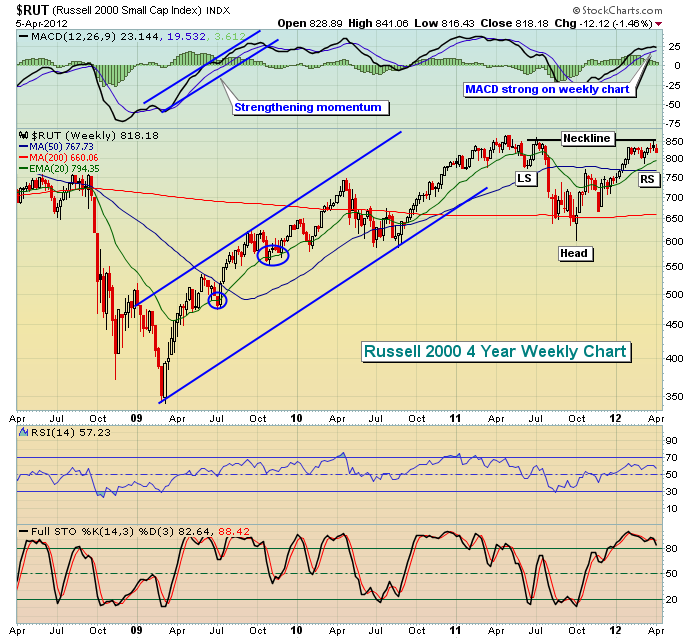I'm not quite sure why, but there definitely is a positive bias towards small cap stocks as we approach the Spring season. April and May are the 2nd and 3rd best calendar months in terms of annualized returns on the Russell 2000. Only December boasts a better monthly record since 1988. Over the past five years, the absolute performance of the Russell 2000 during April and May are as follows:
2011: +0.6%
2010: -2.5%
2009: +18.6%
2008: +8.8%
2007: +5.8%
2007 through 2011 has been a tumultuous period, but the action in small caps has been mostly positive during this April through May time frame. Thus far in 2012, April has started off a bit rough with the Russell 2000 down approximately 1.5%. Further deterioration in prices in the near-term could become an opportunity based on historical trends.
Technically, the Russell 2000 is in decent shape although there is downside risk in the near-term. Given the weak job numbers on Friday, more selling is a definite possibility this week.
Let's take a look at the bigger picture. Below is a 4 year weekly chart on the Russell 2000:

There are a number of ways to view the stock market technically. There are bullish and bearish takes. But the above technical pattern could certainly be argued in a bullish light and that's the position I'm taking until further signs of technical deterioration surface. We've seen an obvious uptrend off the March 2009 lows. It's been an extended period of buying, only temporarily derailed on a couple of occasions. If we consider the move from March 2009 through April 2011 to be "the uptrend", then a bullish consolidation pattern - the inverse head & shoulders pattern - could be a springboard to further gains later in 2012 and beyond. I'm not saying it will happen, but technically it's one pattern worth watching.
During the first six months of 2011, the Russell 2000 held price support at 773 on multiple occasions, which would represent the inverse left shoulder. Once that support level failed, the inverse head printed on the early October low. Note that the subsequent rally into the latter part of the first quarter of 2012 tested the neckline first established back in July 2011. One technical possibility is that we could be in the midst of a period of short-term weakness to print an inverse right shoulder. 773 support would be a very key price level to watch on this potential bout of selling.
Should this pattern continue to play out, the truly exciting part is the measurement, which extends from the neckline down to the inverse head, or 250 points. Therefore, an eventual breakout of this inverse head & shoulders pattern would measure up another 250 points from the 850 breakout level. That would be another 30% upside to 1100. Given other bullish big picture signs, I believe this to be a probable outcome, though certainly no guarantee. We need to see the pattern develop and a breakout occur to confirm the pattern. In the meantime, an aggressive approach would be to accumulate the Russell 2000 (IWM is an ETF that tracks performance in the Russell 2000) during the printing of the right shoulder down to 773. The closer the Russell 2000 moves to 773, the better the reward to risk of long entry.
For Monday, April 9th, I've included a small cap stock that appears to be under significant accumulation as our Chart of the Day. If small caps do hit a rough patch near-term, aggressive traders could look to a pullback in this stock as an opportunity for a trade. CLICK HERE for more details.
Happy trading!
